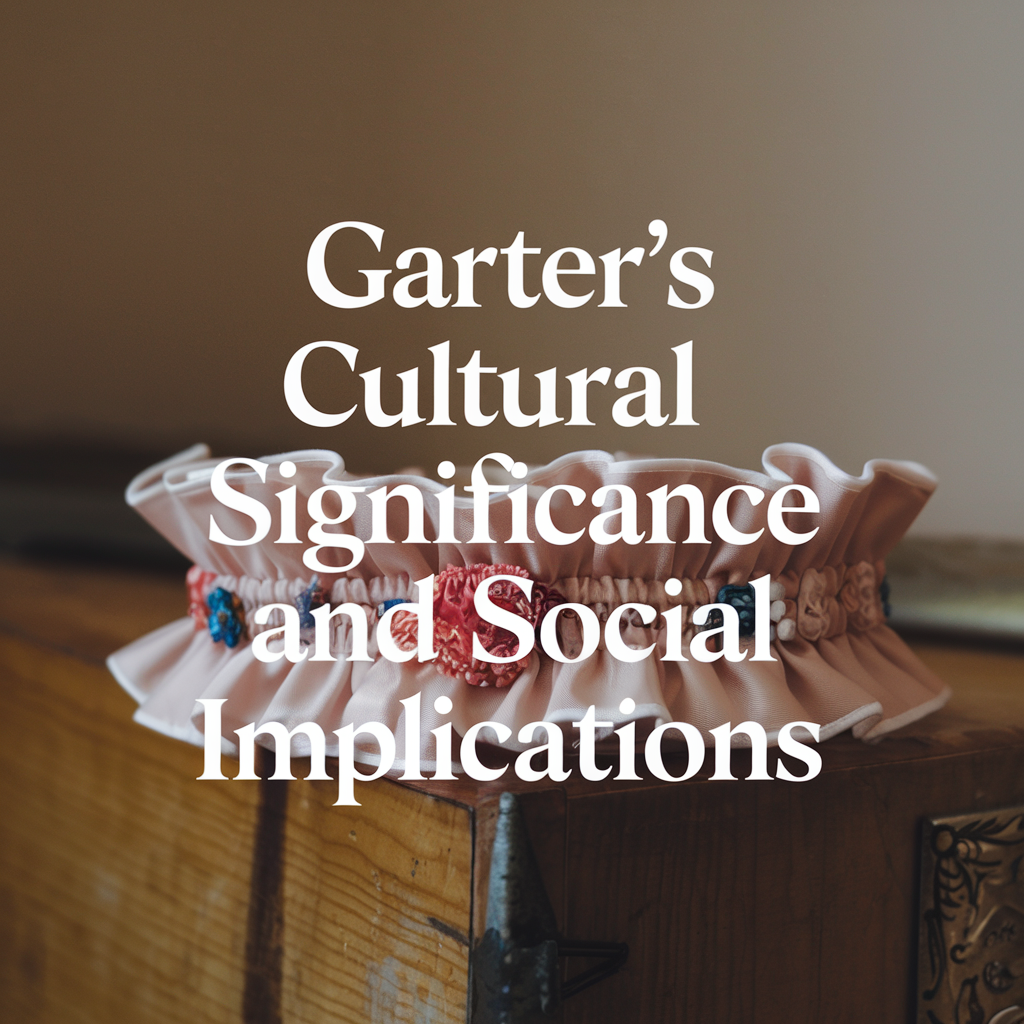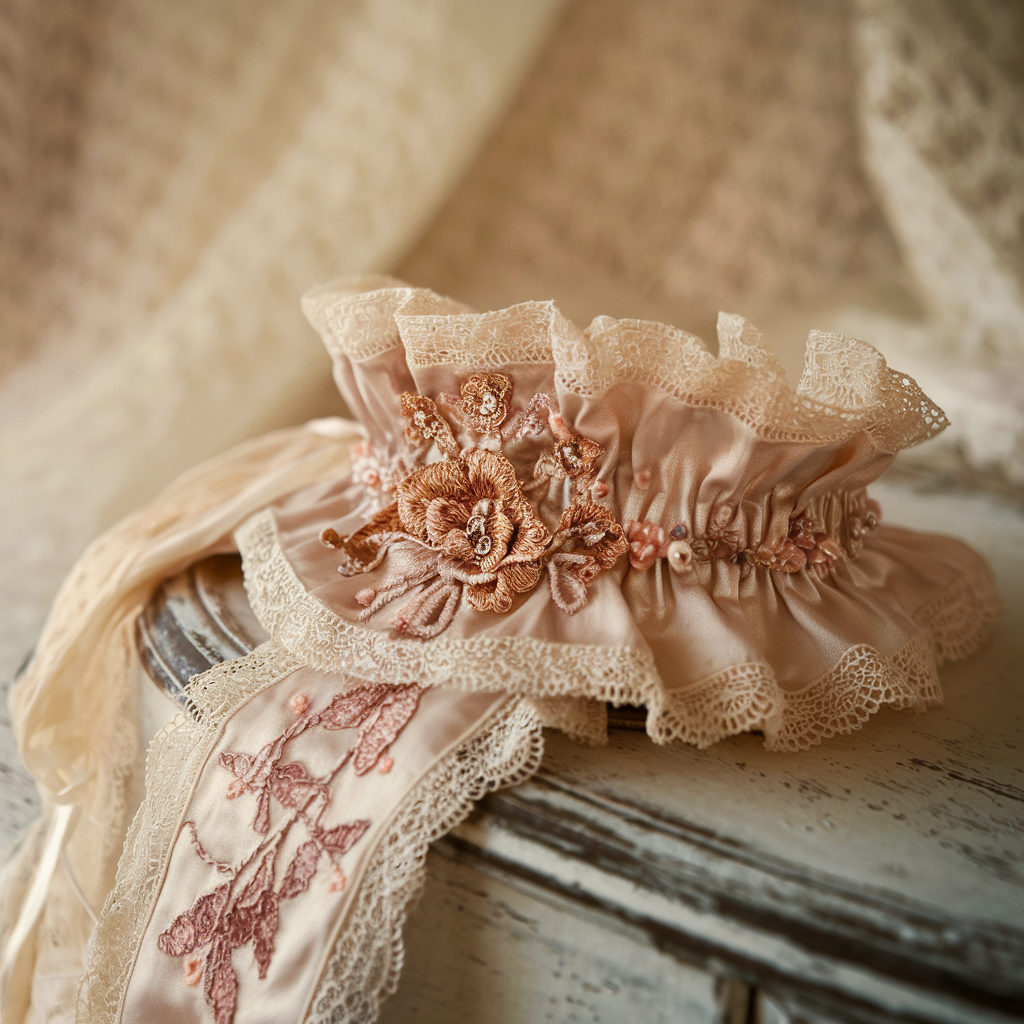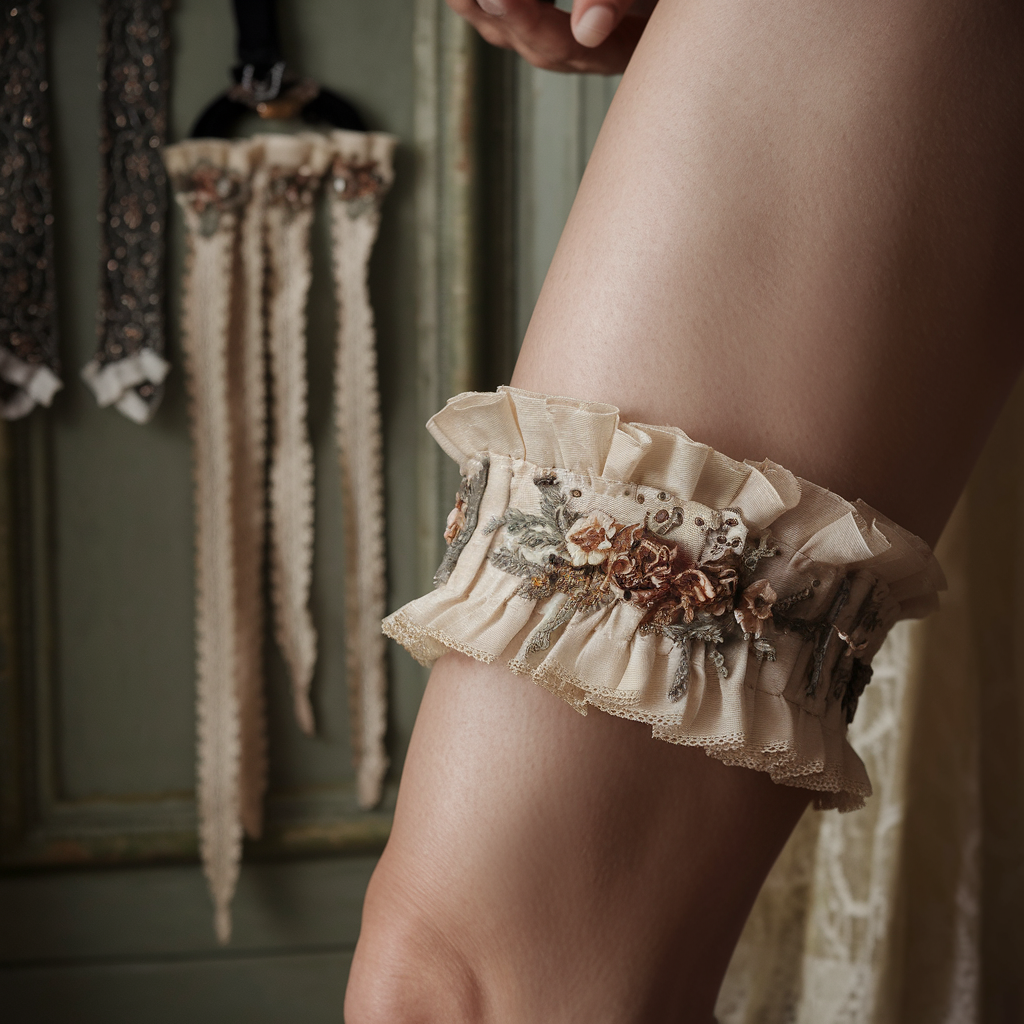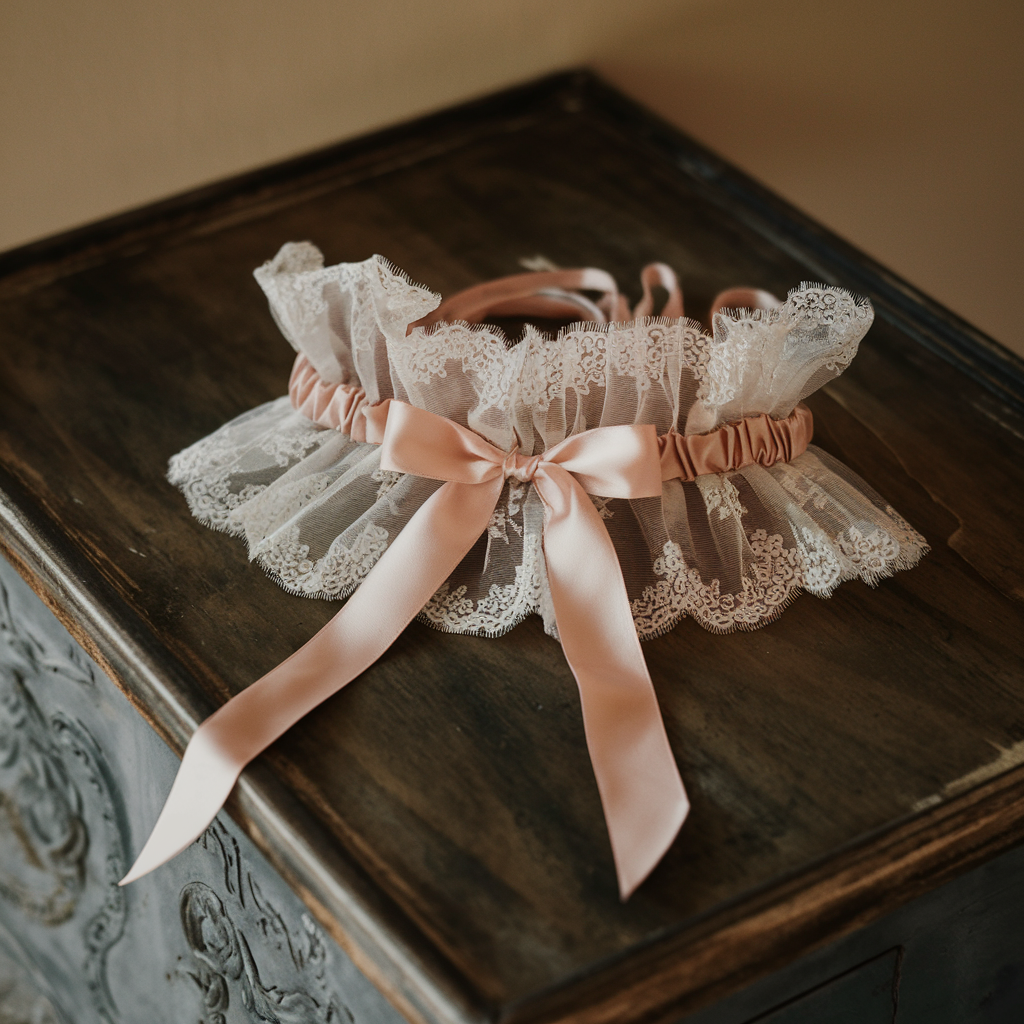Key points
Here are the key points on what the significance of a garter:
- A garter is a band worn to hold up socks or stockings. This simple piece of clothing wraps around your leg to keep things in place. Think of it like a rubber band but softer and prettier.
- The wedding garter is a special tradition many brides follow. It’s a fancy decorated band the bride wears under her dress.
- Garters also have fashion uses beyond their practical purpose. They come in many styles – from simple elastic bands to fancy lace pieces with ribbons and bows.
Contents
- 1 Key points
- 2 Introduction to Garters
- 3 Historical Significance and Evolution
- 4 Cultural and Social Implications
- 5 Early Uses and Symbolism
- 6 Garters in Fashion History
- 7 Functional and Decorative Aspects
- 8 Modern Interpretations and Usage
- 9 Cultural Studies and Expert Insights
- 10 Frequently Asked Questions (FAQ)
Introduction to Garters
“The Complete Book of Fashion History” by Marnie Fogg discussed garters as much more than the elastic bands that hold stockings up. They’re bits of fashion with a rich story behind them. A narrow band is worn around the leg so the stockings don’t slip down.
“Garters have both held practical and symbolic meaning throughout fashion. It evolved from a basic utilitarian item, a sign of status, and even an erotic object (Fogg, 2013 p. 78).”
It has been around for hundreds of years and is made from a variety of materials including ribbons, silks, elastics, and leather. Some were plain while others were fancy with gems and lace. Their work has not changed: hold the stockings up.
Historical Significance and Evolution

Men and women wore garters in the 14th century where men used it to hold their hose while women used it for their stockings.
One of the most famous garters led to the Order of the Garter in England. The story is that King Edward III was dancing with the Countess of Salisbury when her garter fell off. Everyone laughed when he picked it up and tied it around his leg.
He said: “Honi soit qui mal y pense” or (Shame on him who thinks evil of it). The valiant soldier of the garter was the motto of the order he founded in 1348.
Garters got fancier in the 18th century. They are often made with silk and have messages or love notes stitched into them. Fogg notes that “These playful accessories were often stitched with messages and some are love tokens from one lover to the other.”
The first major change in corsets happened in the early 20th century. Elastic-made garters are comfier and less likely to cut off blood flow. The rise of pantyhose in the 1960s made garters rare to be worn every day.
Garters went from must-have items to fashion statements and wedding traditions.
Cultural and Social Implications

Garters have always been more than just practical items. It’s more than just practical objects.
Rich people wore garters adorned with gold, silver, and precious gems. The aristocracy often wore garters made of gold and silver and embedded with gems to show their wealth.
There’s also the wedding tradition of the garter toss performed at a wedding. It became a more sensual role when the 20th century came. They became linked with pin-ups, burlesque, and lingerie.
The garter flipped from something hidden that was considered inappropriate to something that is intended to be visible; to show sensuality and feminine power. Fogg notes that “the visibility of the garter became a statement of sensuality and femininity rather than something to be hidden.”
Garters straddle many worlds in today’s time. They’re marriage customs, fashion trends, antique-inspired embellishments, and markers in subcultures like Burlesque and Gothicism. They help in recalling how fashion items can be imbued with significance beyond their simple use.
Early Uses and Symbolism

Garters tell a lot about how people lived and what mattered to them. Let’s look at how garters began and what they meant to people over the ages.
Origins in ancient times
The Romans and Greeks wrapped strips of cloth or leather around their legs to secure their socks. These weren’t fancy – just useful.
Soldiers wore bands called “fasciae” to attach sock-like items to their legs. They needed something to wrap their legs and keep them protected while working or fighting.
The Old French word “gartier” means “garter.” It entered the language in the 14th century.
Symbolism in medieval society
Garters became more than just functional and symbolic in the Middle Ages. It’s more than just a band for stockings – it stands for status, honor, and love.
One well-known tale about garters is from the 14th century in England. King Edward III was dancing when a garter slipped off. Some made fun of him while the king grabbed the garter and tied it to his leg.
The king announced – “Honi soit qui mal y pense” or “Shame on him who thinks evil of it.” This moment brought about the Order of the Garter which is the highest order of chivalry existing until today.
Tournament knights also wore their lady’s garter as a favor and a token. Blue garters are recognized as symbols of love and loyalty.
It then became associated with marital and fertility practices by commoners. Many European wedding traditions say that removing and throwing the bride’s garter has become popular even today.
Marriage rituals that involve removing and throwing the bride’s garter arise from older customs like taking away a piece of her dress for good luck and fertility (Fogg, 2015 p. 71).
Garters also showed status. Fancy silk wedding garters made with gold, threading, or jewels were worn by the rich. You could tell a lot about a person’s standing just by their garter.
Garters in Fashion History

For hundreds of years garters have been around and adapting to the times like us. The initial garter was merely a tie or band that was made of wool or linen. Nothing fancy; just practical.
The wealthy turned garters into fashion statements and status symbols. They used silk, embedded it with stone, and added a motto. That was the point—a secret luxury.
The most famous thing related to garters is the Order of the Garter which started in England in 1348. The garter is still active as Britain’s Highest Honor.
Transition through the Renaissance
The Renaissance Period used garters as fashionable items. Men showed them off with their short doublets and hose. These were typically made from silk or satin and embroidered with some kind of motto.
The 16th century brought more changes. Garters got wider and more decorated. People attached them higher on the leg. They used ribbons, beads, and even small bells on them. Fashion plates from this period indicate the importance of these little things in finishing the ensemble.
It was very attentive to the little things that sent a message about Renaissance fashion values. They valued details in decorative items.
Influence during the Victorian Era
Garters became fascinating during the Victorian Empire period. Skirts got wider in the 19th century, petticoats and crinolines came in, and stockings became more fancy.
Women needed better garters to hold everything in place. The Victorians were the first to make garters out of elastic to make them more comfortable and practical.
Garters are mostly sold in matching pairs. They were made of plush fabric that had lace edges and a small bow. A small pouch for coins or love notes was sewn on some Victorian garters.
It has been associated with artwork and literature of the fallen woman. This shows how something so simple can have a lot of meaning (Fogg, 2016).
Wedding traditions also made garters special. Brides wear blue garters for luck as part of the “something blue” tradition which began centuries ago. These practical items become fashionable and vice versa (Fogg, 2016).
Functional and Decorative Aspects
Garters were originally bands of material that helped keep stockings up – a real problem before the invention of elastic.
“They are usually statements of wealth and status (Fogg, 2017 p. 83). The wealthy used silk, velvet, and even gold thread to make their garters stand out; even if nobody saw them except for their servants.
Practical uses in clothing
Garters for both men and women are useful in keeping their stockings.
But this was before the introduction of elastic in the 1800s when garters were the sole item that could be used for tying or holding their stockings.
Men who didn’t wear garters (or without their suspenders) had their stockings bunched up at the ankle – making walking awkward and looking a little sloppy. Men should tie their garters below the knee. Women should wear their garters above or below the knee depending on the fashion.
It is also used for holding up socks in some working-class styles to secure the pants to boots. Garters had to not be too tight that they cut off blood but had to be tight enough to hold things up.
Evolution into a fashion statement
In the 1700s garters started to mean more than just something to hold up stockings. Couples exchanged garters with messages or promises stitched into them.
The Victorian era made garters more elaborate and often made out of lace. The 1920s saw the rise of hemlines as more legs became visible and more stylish.
Bridal garters and Burlesque garters that you see today show how this item has become mostly decorative. Garters were once hidden but have a visible role today: in clothes worn by brides and at the pole by Burlesque performers.
Modern Interpretations and Usage

Marnie Fogg said that “modern garters have moved from practicality to a symbol of tradition, sensuality, and fashionable statement in their own right. They are more just functional ones (Fogg, 2017 p. 142).
Role in contemporary fashion
A fashionable garter is the common meeting point of fashion and wear. Designers put them front and center in runway shows; they do not hide.
Fashion historians suggested that the garter is not an undergarment anymore. They have been shown in ready-to-wear and haute couture. This shift connects to how women’s fashion now often toys with what used to be intimate apparel.
Garters are most commonly available today as part of lingerie sets. What’s cool is how they mingle the old and the new – keeping the original forms while making them modern.
Garters in bridal and formal wear
The wedding garter is probably one of the oldest uses of a garter.
American weddings still enjoy the popular tradition where the groom removes one of the garters and tosses it to the single men.
Fogg states that “the wedding garter is one of the very few accessories that have a touchable connection to the medieval traditions of marriage.”
Garters are making an appearance in fashion formal wear. They give a glamorous look to evening wear; often seen peeking out from thigh-high slits.
With the right exposure – old fashion items can become new and trendy.
What sets today’s garters apart is their blend of tradition and individuality. Many brides like choosing a garter to represent their personality, theme colors, and custom embroidery or heirloom.
Cultural Studies and Expert Insights
The amount of cultural value carried by this little band of fabric has been enormous – something that lends us a story and history.
Research on garter symbolism
Garters went from clothing aids to something jam-packed with meaning. It evolved from a simple functional item in the medieval period into a token of love or a sign of affection (Fogg, 2017).
They started to represent something more racy, artsy, and more feminine.
Expert opinions on garter evolution
Experts point 1920s as a turning point for garters. Valerie Steele said that garters became less concealed and more decorative when hemlines went higher.
Anthropologist Ted Polhemus states that the garter toss traces its roots to ancient fertility rituals. “These have been done for eons when the guests would try for a piece of the bride’s clothing for good luck.”
Cultural studies expert Elizabeth Wilson noted that garters continue to be used for erotic purposes even though they have lost their daily function.
The change in the garters helps us understand the social messages. They may have originated as a simple way of holding up a stocking but it went far beyond that—signifying much about the times in which it was worn.
Frequently Asked Questions (FAQ)
How did the wedding garter belt tradition start?
The wedding garter belt tradition has roots in medieval times when garters were used to hold up stockings. Historical sources cite that guests would rush to obtain a piece of the bride’s dress for luck. The tradition evolved into a more ceremonial practice where the groom removes and tosses the garter to bachelor guests.
What are custom garter designs?
Custom garter designs allow brides to add personal touches like monograms, wedding colors, or meaningful fabric. This type of personalization transforms a simple accessory into a special keepsake with significance beyond the ceremony. Many women choose lace garters with blue elements to fulfill the “something blue” custom.
Is there a connection between garters and Order of the Garter?
The Order of the Garter shares historical connections with the wedding dress garter tradition through its symbolic meaning. This historical element influenced how garters became associated with virtue and character in wedding customs.
How do modern couples adapt the garter toss?
Modern couples often adopt the garter toss to make it more fun and less focused on the intimate aspect of the groom retrieving it from under the wedding dress. Some brides wear the garter higher on the leg for easier access or skip the under-dress display entirely. Many weddings now pair the garter toss with the bouquet toss as complementary activities for single men and women guests.
Can garters be worn at other events?
Garters appear at other events like high school prom as a fashion accessory. The prom garter usually sits just above the knee and serves as a decorative addition rather than a functional clothing item. This fashion trend shows how garters have transcended weddings to become part of other formal occasions.
Are there cultural differences in garter traditions?
Cultural differences in garter traditions exist across various countries – with some cultures emphasizing different interpretations of what the garter symbolizes. Research shows these traditions vary greatly with some cultures viewing it as a symbol of the union while others see it as a token of good luck.
What alternatives exist to the garter toss?
Alternatives to the garter toss include giving commemorative tokens to a chosen group of guests rather than tossing an intimate article of clothing. Some couples replace the tradition with a special dance or activity that aligns more with their sense of ceremony. Wedding Ideas sources indicate many modern couples seek ways to honor tradition while making it their own.
When did garters transition from practical to ceremonial?
Garters transitioned from practical to ceremonial during the eighteenth century when fashion trends changed how stockings were held up. Historical citations show this shift coincided with garters becoming more elaborate in design marking their evolution from functional suspender belts to decorative accessories.
What materials are used for wedding garters?
Wedding garters traditionally feature lace as the primary fabric but often with satin ribbon or elastic band for comfort. Many bridal accessories now include decorative elements like pearls, crystals, or family heirlooms sewn into the design. The beauty of the materials reflects the garter’s transition from a practical garment to a symbolic wedding element.
How has technology influenced garter customs?
Technology has influenced garter customs through social media sharing of unique garter designs and toss moments during the reception. Wedding industry professionals used digital platforms to reinvent traditional practices. Today’s wedding dress garters often include tech-friendly touches like hidden pockets for small items or breakdown-resistant materials that maintain their shape throughout the ceremony and festivities.

I’m Kary Walters, a wedding planner and writer with a passion for helping couples stay together and achieve their relationship goals. With over a decade of experience, I specialize in self-improvement and have worked with individuals & couples facing challenges.